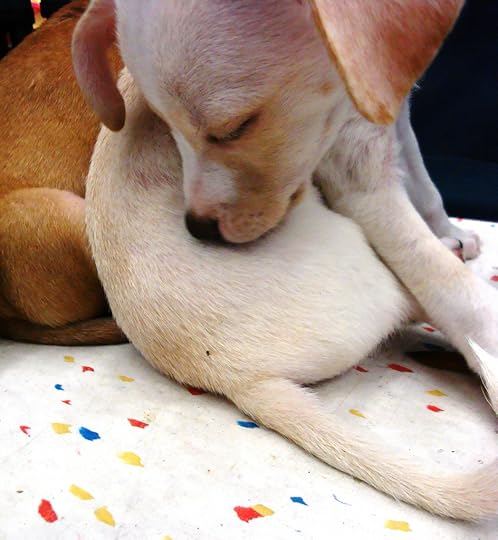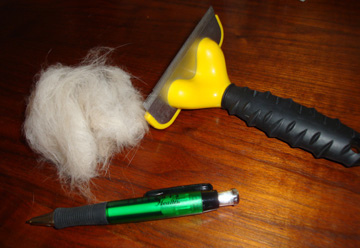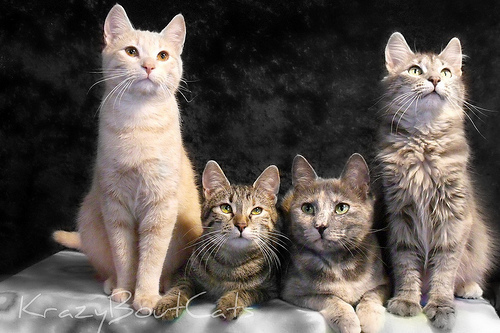Amy Shojai's Blog, page 134
May 11, 2012
Furry Friday: Mother’s Day for Pets

“This is MY purr-son!” Copr. Maria Magnus/Flickr
There’s no doubt we love our pets—but do our cats and dogs love us back? Kitty and doggy shows of affection aren’t always what humans expect. In fact, a pet’s lovey-dovey wishes might instead puzzle, aggravate or even offend some people. To celebrate Mother’s Day here are 14 ways dogs and cats show love.
Cat purrs can mean everything from delight to expressions of concern. A cat that purrs while snuggled in your lap expresses deep trust and love for you. Return the favor and talk back—say, “I love you!” She’ll understand the emotion, if not the exact words.
Dog howls aren’t nearly as subtle as kitty purrs but can be a canine Valentine. A howl can mean your dog is lonely. Try scheduling extra face time with your special dog, or offer puzzle toys filled with treats to show your love. It’s harder to howl when chewing something yummy.
Kitty rubbing against you leaves the cat’s scent—marking you as “owned” by them. Cats repeatedly head-bump their most favorite people. Bumping your face is the ultimate show of trust since it leaves eyes vulnerable.

“I trust you no matter what…” Copr. Paul Loades/Flickr
Dogs lean against us. Yes, it can be pushy or awkward especially with big dogs, but it’s a way of showing and asking for love and attention. Either sit down so he can lean and love, or teach him to “sit” before you dole out the attention.
Kitties groom other cats—or humans—that they like. Licking your skin or hair, or even nibbling or sucking on your clothing spreads “family” scent and is an expression of feline love. Return the favor—petting your cat is the kitty equivalent of a love-fest of mutual grooming.
Dogs jump up, not to knock you down, but to give a big kiss. A dog kiss isn’t exactly the same as human kisses. Puppies lick the mom-dog’s eyes and face to show deference. Adults give doggy kisses to humans they love and respect and aim at the face. Kneel to let him kiss you (if doggy smooches don’t bother you). Or offer your hand for a sniff-and-smooch instead.
Cats scratch and pee to calm themselves down, and seek out items that smell most like their beloved human. So scratching your favorite chair or “baptizing” your bed with urine actually is a backhanded kitty compliment. Relieving stress and providing legal scratch and potty opportunities encourages kitty to love you in more appropriate ways.
Puppies pee and roll on their back when owners come home—another way to show deference and declare their love and respect. Most pups outgrow the pee-party, but not the rolling over. Baring his tummy invites a friendly rub, so answer his request to show you love him, too.
Cats knead—honestly, we’re not sure why. Kittens do it to prompt mom-cat’s milk to release. We suspect this instinctive behavior hearkens back to that feeling of comfort and joy. So a cat kneading her human certainly can be a kitty Valentine.
Dogs chew to relieve stress and calm upset feelings, and also seek out owner-scented items like shoes or that Gucci handbag. Why not offer him a Valentine’s gift of a legal chew toy—stick it inside your shoe overnight so it has the appropriate “cologne” to really show your love!
Dog crotch sniffs may not seem all that loving but are the equivalent of a human hand shake. Request a “sit” instead, then pay him with attention.
A kitty butt-in-your-face is an invitation to sniff—that’s a very friendly and loving gesture! (Not that you want to indulge). Scratch the base of her tail, instead.
Doggy wags that are low, loose and wide are technically a “distance-decreasing signal” that invites attention and love. Tail-less dogs wag their whole body.
Kitten tails held straight up with the end tipped over use this to greet mom-cat, and the tippy-tail is a kitty Valentine when directed at humans—in effect calling you “mom.”
What have I missed? How do your fur-kids show you love–on Mother’s Day and the rest of the year? You can show your Mother’s Day love by “gifting” the pet lovers in your life with something for their pets–maybe even a book (hint hint!).
I love hearing from you, so please share comments and questions. Do you have an ASK AMY question you’d like answered? Do you have a new kitten and need answers? Stay up to date on all the latest just subscribe the blog, “like” me on Facebook, listen to the weekly radio show, check out weekly FREE PUPPY CARE newsletter, and sign up for Pet Peeves newsletter with excerpts from the forthcoming THRILLER, LOST & FOUND, and pet book give-aways!
Filed under: Cat Behavior & Care, Dog Training & Care Tagged: Amy Shojai, cat behavior, cat books, dog behavior, dog books, dog training, Mother's Day, www.amyshojai.com

May 9, 2012
Woof Wednesday: Food, Glorious Food & Worry-icity!

“Look pitiful–THAT’S how you get treats!” Awesome picture copr. Craig Logan via Flickr
You are what you eat applies to pets just as much as it does to people. After the pet food recall (you remember, the one that killed a bunch of pets and turned the pet food companies into damage control demons?), a lot of dog and cat folks morphed into DIY feeders. In fact, a friend of mine and great pet person and awesome journalist Arden Moore’s fun gift book REAL FOOD FOR DOGS became a best-seller when owners went looking for alternatives. Note: this is a fun book with recipes for treats and suchlike, not for a daily diet, so is great as an adjunct to your dog’s main food.
PROS & CONS OF HOME FEEDING
The veterinary community as well as the FDA cautions pet owners about home cooking food and especially raw diets for two reasons. First, it’s very difficult to create a nutritionally sound diet for your pet on a sustained basis.
Oh, don’t get me wrong, I have friends who have done this for YEARS with great success but it’s not for me–I don’t even cook nutritionally sound meals for myself, LOL! (Cheetohs and M&Ms are my friends…). But with a sound recipe from a vet nutritionist (www.petdiets.com is a good resource) it can be done very successfully, and is particularly helpful for pets with therapeutic dietary needs.
Second is the fear of food contamination, and salmonella is a real danger more for people (especially kids and immune compromised folks) than for pets. Safe handling of food is a must even with people food, though. The fear has been that widespread home cooking and/or raw feeding could result in an outbreak of salmonella.

“Num, num, num, num…”
PET FOOD RECALL–REDUX
Yes, it’s happened again and the culprit is salmonella. But it’s not home cooking folks or raw feeders, but commercial foods once again. BRAVO to Diamond Foods, the manufacturer/packager of a number of brands, that kicked off a VOLUNTARY RECALL as a precaution even though only small amounts of product actually was suspected to be a problem. Since that initial announcement, additional foods–dog, puppy, cat, kitten–and brands have been added to the recall list. Brands include:
Chicken Soup for the Pet Lover’s Soul
Country Value
Diamond
Diamond Naturals
Premium Edge
Professional
4Health
Taste of the Wild
Apex Foods
Solid Gold
You can find links to the various products along with batch codes and dates to ensure your pets’ foods are still safe or should be returned in this recall blog.
PET FOOD SELECTION
How do you know a pet food is the best for your furry wonder? Every pet is different, of course, but there are ways to figure things out. Reading labels gets you part of the way there–but the labels are a legal document and serve to satisfy the regulators more than they do to inform the public. There are terms that have legal definitions but can be misinterpreted by pet owners (ain’t that the way legalese works?), and even some ways the labels can mislead (accidentally on purpose, LOL!) to get you to open up your wallet. After all, dogs don’t have thumbs or bank accounts so it’s up to us to choose wisely.
Here are a few links to further information about pet foods–much of this applies to cats, too:
What IS That? Additives In Food
So what do you feed your furry wonder? What does your veterinarian recommend? Do you rely on other “expert” advice and if so, where do you get your information? Have you been affected by the pet food recall? How do you advise your pet-loving friends? Do tell!
I love hearing from you, so please share comments and questions. Do you have an ASK AMY question you’d like answered? Do you have a new kitten and need answers? Stay up to date on all the latest just subscribe the blog, “like” me on Facebook, listen to the weekly radio show, check out weekly FREE PUPPY CARE newsletter, and sign up for Pet Peeves newsletter with excerpts from the forthcoming THRILLER, LOST & FOUND, and pet book give-aways!
Filed under: Dog Training & Care Tagged: Amy Shojai, dog diet, dog food, home cooked dog food, pet food, pet food labels, pet food recall, puppies.About.com, raw food, salmonella, www.amyshojai.com

May 7, 2012
Monday Mentions: Contests, Dog Meets Wolf & PET FOOD RECALL!

“Deadlines” won 2nd place in the suspense/mystery category!
This past weekend I attended the annual OWFI Conference and had a ball. It’s as much about reunions and connecting with like minded folks as it is attending the stellar seminars. I had a ball moderating a panel on social networking, was a judge for the contest, and attended sessions on “building brand” and perfecting your elevator pitch to using screen writing techniques to improve writing with Tom Sawyer (of Murder She Wrote fame).
Steven James the thriller writer, poet, and more was the keynote speaker and was the BEST I have ever heard at this conference or elsewhere! I laughed until I cried, was inspired, and came away with a new determination to “throw my hat over the wall.”
I love this conference also for the encouragement and inspiration that arises from the contest–for unpublished work mostly–that garners helpful comments. I even recommended a handful of editors and agents to the contest chair to see if they wanted to judge. The contest is judged “blind” so nobody knows who entered what and the judges aren’t announced publicly until after the winners are announced. I entered my thriller. It was the 4th time I entered.
The first year it was disqualified (the judge failed to find the synopsis). The second year, the mail lost the entry. Last year the judge rated the manuscript about a 15 out of a possible 100 points because “everyone knows dog viewpoint only belongs in kid books.” This year the judge awarded that same manuscript 2nd place! As it turns out, two months after entering the contest I submitted my thriller to an editor who bought the manuscript–and until this weekend I hadn’t a clue that she’d already seen it in the contest! Yes, my editor was that category judge and (perhaps?) as a result of entering the OWFI contest I had a paw-up in getting an acceptance. Wow! The book (new title, LOST AND FOUND) will be published this fall.
Monday Mentions is the mash-up-day of all the neato-torpedo links and videos, pet schtuff and bling and writer-icity crappiocca collected over the past week. Some of this “schtuff” can be hard to categorize and may fit more than one topic so I urge you to at least scan them all.
PET SCHTUFF
DIAMOND PET FOOD RECALL has been expanded due to fears of salmonella contamination and includes several brands for both dogs and cats. Check the link for further info to be sure your pets’ foods aren’t on the list. Spread the word!
A DOG’S LIFE BLOG on PET PARTNER EVALUATIONS from Patricia Tirrell, an awesome post for those interested in learning about therapy dogs
PET’S EYE VIEW CAMERAS these attach to the collar–pricy but looks like fun
CAT MAN DREW Mother’s Day Special kitty portraits, awesome!
The AKC Humane Fund, Inc. offers the John Spurling, O.B.E. Scholarship Celebrating the Human-Canine Bond. Five scholarships will be awarded annually to full-time students enrolled in courses of study that advance responsible pet ownership.
DO YOU WANT “KITTY” WITH YOUR COFFEE? a cat cafe complete with snuggles…in Vienna
CANINE SERVICE DOG FOR–ANOTHER DOG? awesome video, a must-see!
WRITER-ICITY SCHTUFF
CONTEST FOR DOG WRITERS from the Universal Cavalier
DO YOU NEED A BIG SOCIAL MEDIA FOLLOWING? one writer’s experience and insight
THE MILLIONAIRE’S WIFE interview with true crime author Cathy Scott–you’ll be inspired how she jumped ship on a “safe” job and became a best selling author.
MICROSOFT INVESTS IN B&N DIGITAL
WRITE-WELL ACADEMY from Jennifer Crusie and Lani Diane Rich provide online workshops for beginning and advanced writers.
Now for some pure fun, check out this video and the dog’s reaction to the “wolf.”
I love hearing from you, so please share comments and questions. Do you have an ASK AMY question you’d like answered? Do you have a new kitten and need answers? Stay up to date on all the latest just subscribe the blog, “like” me on Facebook, listen to the weekly radio show, check out weekly FREE PUPPY CARE newsletter, and sign up for Pet Peeves newsletter with excerpts from the forthcoming THRILLER, LOST & FOUND, and pet book give-aways!
Filed under: Cat Behavior & Care, Dog Training & Care, Writing Advice & More Tagged: Amy Shojai, cat books, Diamond Foods, dog books, OWFI, pet food recall, Steven James, www.amyshojai.com

May 4, 2012
Feline Friday: Second Story Cats & Countertop Cruising

Cats become pests with their determination to stay above it all. They cruise kitchen countertops, lounge atop doors and leap to refrigerator tops to ambush treats.
The urge to be the top cat seems a universal kitty vice. By understanding why cats scale the heights, cat owners can provide legal outlets that keep both the kitty happy, and out of the owner’s butter dish.
Why Cats Love Heights
Cats come pre-programmed to seek elevated lounging spots. Think about it–a kitty walking on the wild side wants to see enemies (and potential munch-able critters) but remain invisible. A cat quite literally believes she “owns” the space she can see.
Cats also control each other’s interactions—or even the dog’s movements—with pointed stares. This cats-eye-power packs even more punch from an elevated perch, giving the cat ownership and control over even more territory. The cat that commands the highest perch is the high-cat-on-the-totem pole in that particular room.
What’s The Attraction?
Individual cats may have specific preferences for lounge spots. But in general, there are five reasons cats seek a particular place.
Height. The taller the perch, the more important the cat.
View. Perches near important pathways like windows or stairways offer high kitty value.
Warmth. Cats are furry heat-seeking missiles, so the tops of warm TVs or computer monitors, or snuggled under lamps prove irresistible. My cat loves to sleep in the paper well of my printer.
Comfort. Lounging requires a soft, comfy surface like the back of chairs.
Food. Kitchen counters and stovetops smell yummy or even have snacks within paw reach that keep the cat burglar returning to the scene of the cat crime.
You won’t keep your cat on the ground. Cats tend to avoid low spots with no view, or that are cold and uncomfortable. So give your cat what she wants with irresistible legal perch options and make forbidden spots unattractive.
Grounding High Rise Cats
Evaluate your cat’s favorite perches, and make your choice better. My cat Seren loves to lounge on top of the piano (height) beneath a lamp (warmth) next to the window (view). To purr-suade her otherwise, we placed a three-tiered cat tree that’s TALLER than the piano and has a softer surface (comfort), still under the lamp beside the piano, and still in front of the window.
For your cat household, have at least one cat tree (or acceptable high-value lounge spot) for each cat. Otherwise, they may argue over who gets first dibs.
Make the legal lounge taller than the forbidden object, but nearby so the location remains attractive. An empty bookshelf can work, or even an inexpensive ladder. Put a cat bed stocked with kitty treats on the paint rack.
Make off-limits spots unattractive. Booby-trap counters so they’re no longer comfy. Double-sided tape products like Sticky Paws applied to placemats can be scattered on forbidden surfaces, for example.
Cats hate weird textures, too. Aluminum foil that covers stovetops can keep some cats at bay.
For hard case cats, invest in clear plastic carpet runner to line the countertop, dining table or other illegal location. Just place it nub-side up, and kitty will seek a more comfy spot to lounge.
You can also set up the SSScat! Product, an aerosol can with a motion detector that hisses air to shoo critters away even when you’re not there.
Choose which battles to fight, because it’s hard to win them all—and you want your cat to like you. Seren-kitty isn’t allowed on the mantel because she plays gravity experiments with fine breakables. But she won the battle of the dining room table where she lounges in a plush cat bed beneath a stained glass lamp. I’ve also trained her to exit the printer when I need it. In families, sometimes you must compromise.
What is your cat’s favorite second-story territory? Do you butt furry heads over the location? Has Kitty won the battle or do you compromise? Here’s an Ask Amy on the subject with tips as well but I’d love to hear from you. Please share!

I love hearing from you, so please share comments and questions. Do you have an ASK AMY question you’d like answered? Do you have a new kitten and need answers? Stay up to date on all the latest just subscribe the blog, “like” me on Facebook, listen to the weekly radio show, check out weekly FREE PUPPY CARE newsletter, and sign up for Pet Peeves newsletter with excerpts from the forthcoming THRILLER, LOST & FOUND, and pet book give-aways!
Filed under: Ask Amy Videos, Cat Behavior & Care Tagged: Amy Shojai, Ask Amy, cat behavior, cat books, cat care, cat training, cats on counters, why cats like high places, www.amyshojai.com

May 1, 2012
Woof Wednesday: Making Fleas Flee

I couldn't resist another Magic picture (when he was much younger) in spring Paintbrush.
It’s time for my annual flea rant. This year the terrific rain that made wildflowers resurrect in drought-parched North Texas also provides lush habitat for bugs. Magical-Dawg has been scratching like crazy, even though he’s on a flea preventive. There’s just too darn many bugs out there. The cat flea (also infests dogs) can cause allergies, anemia, and transmit tapeworms as well as the agent that causes cat scratch disease. And even though Seren-kitty doesn’t go outside, Magic generously shares any hitchhikers with her.
KEEP REFILLS A-COMING!
I’ve also had some frustration getting refills on Magic and Seren’s medications. It used to be that the monthly spot-on or oral heartworm medications could be picked up from my veterinary office. For convenience sake they’ve gone to an online website with a “store” that keeps track of the pets’ Rx which can be refilled with the click of a button. Only the past couple of times the pets have been ready for a refill, their meds either were “unavailable” or missing from the online store. Grrr!
So instead of a separate heartworm preventative along with a flea medication I finally broke down and purchased Revolution, a product formulated to take care of most all available parasites. Hopefully that will quell Magic’s itch–I do believe that the fleas build up resistance to certain treatments and it’s not a bad idea to rotate products when possible.
FLEA PRODUCT DANGERS!
Choose flea and tick products with care. Even those that ARE safe (when used according to directions) can cause problems if you fail to use good judgment. Age of the pet, health status, and species determines the type of product you should choose. Look at the label to make sure the flea or tick protection says it’s safe for your individual pets.
Dogs tolerate certain types of pesticides better than cats. Products containing permethrin or phenothrin labeled for dogs can kill your cat. Kittens and puppies must be old enough to tolerate the treatment (the label will say the best age). And using more than one product at a time on your pet can add up and poison him when one alone might be fine.
NATURAL FLEA PREVENTION
The safest and most “natural” flea control technique involves using a flea-comb. Frequent vacuuming of the carpet removes up to 90 percent of flea eggs and 50 percent of larvae, and gets rid of incidental ticks, too. Don’t neglect washing pet beds, carriers, blankets, and throw rugs as well as any sofa cushions or other favorite dog and cat resting places.
For outdoor habitats, cut the grass short to allow sunlight to shoo away the bugs. Remember all those wildflowers and waist-high grass in the pictures on Monday Mention blog? Yesterday the fields were mowed, and that should cut down not only the pollen count but reduce parasite habitat. Keeping your pets from problem areas and treating the bug habitats helps reduce the pest population. Nematodes—worms that eat immature fleas—are available from lawn and garden supply outlets.

Can you see the flea in the picture? Yes, it's there! Ewww!
FLEA BIOLOGY BITES
The adult flea you find crawling through Fluffy and King’s fur represents only the tip of the buggy iceberg. Adult fleas don’t hop on and off your pet. They stay there unless involuntarily dislodged, but they represent only five percent of the total flea population. The remaining 95 percent composed of flea eggs, larvae, and pupae lurk in the environment poised to belly up to the furry banquet.
Fleas can lay 20 to 40 eggs per day, and ten female fleas can create almost a quarter of a million different life stages in a month. Newly emerged flea larvae can survive two weeks without a blood meal, and pre-emerged (pupae/cocoon stage) can survive six months without feeding.
Flea products may address the egg, larvae and adult stages, but no insecticide can kill the cocoon stage. You must wait until it hatches to kill it. It takes fourteen to twenty-one days for the lifecycle to be complete.
Consult with your veterinarian to decide how best to protect your furry family in the bug wars. Some products only are available by prescription. If you choose an over-the-counter product, look at the label and follow product instructions to ensure the health and safety of your pets. You can learn more about fleas and appropriate products in this article, and learn more about ticks here.
How to you keep your dogs itch free and safe from parasites? Do you use “natural” methods along with preventatives? What tips can you offer to others dealing with these nasty vampires? Please share.
I love hearing from you, so please share comments and questions. Do you have an ASK AMY question you’d like answered? Do you have a new kitten and need answers? Stay up to date on all the latest just subscribe the blog, “like” me on Facebook, listen to the weekly radio show, check out weekly FREE PUPPY CARE newsletter, and sign up for Pet Peeves newsletter with excerpts from the forthcoming THRILLER, LOST & FOUND, and pet book give-aways!
Filed under: Dog Training & Care Tagged: Amy Shojai, dog books, dog care, dog itching, dogs, fleas, natural flea treament, puppies.About.com, ticks, www.amyshojai.com

April 30, 2012
Monday Mentions: Fabulous Flowers, Furry Pet Care & Fantastic Writing Tips
Last week I mentioned the 500 antique roses around our house? It used to be 700+ but the drought, armadillos and grasshopper attrition left a dent. You cannot believe the aroma! With all the recent rain, we’re fighting with the weeds but it appears the roses are holding their own or even winning. And so are the wildflowers. As promised, some of my favs are shared here today.
This next weekend I’ll be at the Oklahoma Writers Federation Conference. This is an organization very close to my heart, as I have met some of the most extraordinary writers and friends there, as well as connected with editors and agents. As a result of attending, I ended up writing a Woman’s World pet column for a couple of years, found my agent (we sold 15+ award winning books together!), and also served as contest chair and president. I’m now a life member, wow! This weekend I’ll be moderating a panel on social media. You don’t have to be there, either, to benefit–if you have questions please post in the comments section and I’ll pose them to the panelist and share in a future blog.
Monday Mentions is the mash-up-day of all the TASTY neato-torpedo links and videos, pet schtuff and bling and writer-icity crappiocca collected over the past week. Some of this “schtuff” can be hard to categorize and may fit more than one topic so I urge you to at least scan them all. But first…some N. Texas spectacular-arity because when you’re feeling angst, there’s nothing like a dose of Mom-Nature to set you right.
WRITER-ICITY SCHTUFF
Amazon Rewards Content Creators a great post from LJ Sellers
2012 Agents Conference, Writers League of Texas the registration price GOES UP tomorrow (May 1st)
Winners of the 2-12 Edgars Announced
The London Book Fair from an author’s perspective
Writer Beware! avoid this German literary agent and VERY IMPORTANT info on Reversion Clauses in contracts (trust me, authors, you must read this!)
William Bernhardt Writing Programs Best selling legal thriller author’s seminars, workshops and more come HIGHLY recommended (yes, they’re that good). Bill’s also a thoroughly nice guy.
PET SCHTUFF
Big Head Saves Staffie an awesome come-back story about a dog named Diesel hit by car TWICE–from the awesome Dr. Rayya’s Online Vet Journal
Cats Are Con Artists, Dogs Are Sycophants says a new scientific study. Huh? Say it ain’t so, Fluffy…what’s that? Let me fill up your bowl…
39 Pound Cat?! OMG let me NOT fill up your bowl! And here’s more about MEOW the heavyweight kitty and how he came to be where he is today (thanks JaneA Kelley!)
Singer Chris Brown Sells Pit Bull Puppies Online – there are so many things WRONG with this, I don’t know where to start
Protect Cats from Heartworms! According to the website www.knowheartworms.org, in a North Carolina study 28 percent of the cats diagnosed with heartworm disease were indoor-only cats. It’s been a mild winter–mosquitoes are already out and about. And yes, Seren-kitty takes her preventive like a treat. (So does the Magical-Dawg).
Parasite Prevention from expert Dr. Blagburn from Good News For Pets
American Humane Association’s Second Chance Fund helps animals in disaster situations
Cat owners are urged to speak with their veterinarians about preventive medications for their cats so that they can protect their feline friends from potentially deadly heartworm infestations. For more information on CAPC, visit their website at www.petsandparasites.org.
2012 Petties DogTime’s Pet Bloggers Awards with awards going to help fund animal shelters of the winner’s choice. Nominations open June 4 and broadcast in November.
34th Annual Winn Feline Foundation Feline Health Symposium. Learn all about feline hypertrophic cardiomyopathy June 28, 2012 at the Boston Marriott Quincy, in Quincy, MA from researchers Leslie Lyons, PhD, University of California, Davis (speaking on genetics), and John Rush, DVM, DACVIM, DACVECC, Tufts University (causes, diagnosis, treatment).
Hemingway Cats Case Awaits Federal Appeal The approximately 40 felines descended from the famous author’s “breeding” program continue to live on the grounds of the Hemingway Museum–should they be caged?
Fact Or Fiction: 10 Diet Myths Debunked, a fantastic post from the excellent blogger August McLaughlin
This terrific video “This Too Will Pass” was pointed out to me from terrific blogger Piper Bayard.

I love hearing from you, so please share comments and questions. Do you have an ASK AMY question you’d like answered? Do you have a new kitten and need answers? Stay up to date on all the latest just subscribe the blog, “like” me on Facebook, listen to the weekly radio show, check out weekly FREE PUPPY CARE newsletter, and sign up for Pet Peeves newsletter with excerpts from the forthcoming THRILLER, LOST & FOUND, and pet book give-aways!
Filed under: Cat Behavior & Care, Dog Training & Care, Writing Advice & More Tagged: Amy Shojai, cat behavior, cat books, cat care, dog behavior, dog books, http://www.amyshojai.com, http://www.shojai.com, Oklahoma Writers Federation, pet books, roses, wild flowers, writers conference, writing

April 27, 2012
Feline Friday: National Hairball Awareness Day

That blue bed is as hairy as Seren-Kitty!
Do you know what today is? It’s National Hairball Awareness Day! RomeoTheCat and FURminator are once again co-sponsoring an event to bring attention to this big-hairy-deal.
Have you ever discovered the latest squishy “kitty creation” by stepping on it, barefoot, at 3 a.m.? Ewww!
Cats, and some dogs (Pomeranian owners, am I right?!) swallow fur during self-grooming. Hopefully it ends up in the litter box or yard. But when it comes out the other end, the cat vomits hotdog or cigar-shaped hairballs.

Cats spend 30% of their lives grooming.
Shedding season increases the odds kitty will “urk” more often, especially in longhair cats. The techie term for hairball is a “bezoar.” I warn you, don’t click that link until after breakfast. I’m not posting a picture cuz I don’t want readers to “urk.” (Turns out, humans get bezoars, too, Ewww!)
I’m fortunate that Seren has short fur, but even that can accumulate and be swallowed. We kid that fur in a pet home should be considered a condiment, but if kitty swallows too much, it stops up the system. Baseball-size hairballs have been removed from cats. Most cases won’t need surgery, though, and most hairballs can be easily eliminated.

That's a wad won't go into the cat, or stain my carpet on the way out.
The no-brainer solution is to groom kitty and pull off the fuzz before it gets swallowed. I have grooming tools–the dog Furminator (above) is awesome and works especially well on the Magical-Dawg. (I don’t even wanna think what size bezoars he’d produce!)
I received a kitty-size Furminator to test on Seren-kitty for this month. She is IN LOVE…I have the handy grooming tool next to my chair. Each evening Seren arrives for a session of lap-snuggling and purr-icity while the kitty Furminator massages her whiskers to tail. She has not “urked” up a hairball this whole month, ever since we began getting rid of the extra fuzzies.
Here are more ways to manage hairballs. Do your cats get hairballs? What do you do to prevent ‘em? What about your DOGS and hairballs? Cats that groom dog friends increase their hairball risk, too. Do your fur-kids like or loathe grooming. What are some tricks you use to keep a handle on fuzzy-icity? Please share!
Groom the cat. The cheapest, easiest hairball cure is to regularly comb and brush your cat. Any hair you remove won’t be swallowed to end up staining your upholstery. The Furminator eliminates up to 90 percent of shed fur.
Feed a hairball diet. A variety of commercial products are designed to prevent hairballs. They include extra nondigestible fiber. That helps push swallowed hair through the digestive tract, so it is eliminated naturally with each bowel movement.
Add some fiber. If you’d rather not switch foods, just add fiber to kitty’s regular diet. Mix in a teaspoon of plain bran or Metamucil to canned meals. Flaxseeds or psyllium husks, available in health food stores, also act as natural laxatives and work well. Add ¼ teaspoon of flaxseeds or psyllium for every meal.
Offer pumpkin. Canned pumpkin—the plain type, not for pies—is very rich in fiber and cats often love the taste. Get a jumbo-size can, and divide into teaspoon-size servings and freeze in an ice cube tray. Thaw one serving at a time, mixing into the regular food or offer as a treat once or twice a week.
Give a bit of honey. If your cat doesn’t appreciate canned pumpkin, you can offer a natural laxative, two or three times a week. Combine raw oatmeal, honey, and olive oil into a paste. Offer one to two tablespoons as a treat when hairballs are a problem.
Lubricate the gut. Butter will make your cat purr, but it won’t help hairballs. Digestible fats like butter can cause diarrhea and usually get absorbed before they can move the problem out. Instead, offer non-medicated petroleum jelly. It looks nasty but many pets like the taste. It will coat the hairball to make it slide more easily out of the system. If kitty refuses to accept a finger-full scraped into his mouth, just spread the jelly on his paw so he has to lick it off as he grooms. Commercial hairball remedies often add salmon or malt flavoring to similar petrolatum products. Take care to follow label instructions or your veterinarian’s advice, though. Overuse of these products can interfere with the pet’s use of fat-soluble vitamins.
I love hearing from you, so please share comments and questions. Do you have an ASK AMY question you’d like answered? Do you have a new kitten and need answers? Stay up to date on all the latest just subscribe the blog, “like” me on Facebook, listen to the weekly radio show, check out weekly FREE PUPPY CARE newsletter, and sign up for Pet Peeves newsletter with excerpts from the forthcoming THRILLER, LOST & FOUND, and pet book give-aways!
Filed under: Cat Behavior & Care Tagged: Amy Shojai, bezoar, cat care, cat grooming, Complete Kitten Care, Furminator, hairballs, http://www.amyshojai.com, http://www.shojai.com, kittens, National Hairball Awareness Month, PawNation.com, pet shedding, pets, Romeo The Cat








April 25, 2012
Woof Wednesday: False Pregnancy & Zinc Neutering
Everyone knows that pets get pregnant if precautions aren’t taken, but did you know they also can suffer false pregnancy? Today’s Ask Amy address this situation, but I’ve got a BONUS VIDEO for you as well.
ZINC NEUTERING
The girls still require spay surgery and in most cases the boys are surgically neutered. But a new procedure that uses injections can neuter your boy dogs with very little muss or fuss. I’ve wanted to interview these folks for some time and we keep missing each other on schedule so hopefully sometime in the future you’ll hear a radio interview.
But in the meantime, check out the awesome video below of the procedure–fellows, I can see you crossing your legs now. Don’t be a weenie, this isn’t an ooky procedure at all and is a great paw-step forward.
At what age did you have your fur-kids neutered? Or have you decided not to sterilize them–could you share why? If it were available, would you elect to go with zinc neutering?


I love hearing from you, so please share comments and questions. Do you have an ASK AMY question you’d like answered? Do you have a new kitten and need answers? Stay up to date on all the latest just subscribe the blog, “like” me on Facebook, listen to the weekly radio show, check out weekly FREE PUPPY CARE newsletter, and sign up for Pet Peeves newsletter with excerpts from the forthcoming THRILLER, LOST & FOUND, and pet book give-aways!
Filed under: Ask Amy Videos, Dog Training & Care Tagged: Amy Shojai, Ark Sciences, dog behavior, dog care, dog false pregnancy, www.amyshojai.com, zinc neutering








April 23, 2012
Monday Mentions: Stroke-icity, Convict Cats & Dining Dogs

Yep, that's Magic when he was a lil' guy. That rose has grown up, too, and still dwarfs him.
This week will be so busy that you may not see much of me–virtually or otherwise. I’ve received back my awesome editor’s revision notes on my thriller LOST AND FOUND and so have cleared my desk to concentrate on that. Never fear, I’ll have blogs for you this week prepared in advance.
Meanwhile for brain food, in the evenings I start rehearsals for the part of Golde in Fiddler On The Roof. For stress relief there’s playtime with the Magical-Dawg and Seren-Kitty…and spending time in the roses.
Did I mention that about 500 antique roses surround our house? It used to be 700+ but the drought, armadillos and grasshopper attrition left a dent. You cannot believe the aroma! Before the weather gets too hot, I plan to spend time with the laptop out on the patio. BRAINSTORM! That’s the perfect place to work on the fiction revisions. I feel better already. 
Monday Mentions is the mash-up-day of all the TASTY neato-torpedo links and videos, pet schtuff and bling and writer-icity crappiocca collected over the past week. Some of this “schtuff” can be hard to categorize and may fit more than one topic so I urge you to at least scan them all.
WRITING SCHTUFF
Stroke From The Inside Out Dr Jill Bolte Taylor, a brain researcher, experienced a stroke and describes the process. Amazing! For writers, this is a must-see video and will give incredible insight into characterization. Thanks to D.P. Lyle for the link.
How To Write A F…antastic Blog use the “F”
Line In The Sand, must-read blog by Lisa Hall-Wilson for all fiction writers. Excellent post!
Competing With Amazon? Kill DMR! an interesting discussion by Charlie Stross (thanks to the awesome WriterBeware blog for the link)
PET SCHTUFF
How Not To Get A Cat, a fun blog any cat lover (or writer) will enjoy!
Dog TV? you betcha, Fido! Thanks to Piper Bayard for the paws-up mention
The Farley Foundation helps owners who can’t afford pet health care
Cats In the Klink a cats-in-prison program that helps inmates and cats, awesome! Thanks to my friend and awesome cat writer Toni Eames for point out this story.
Stacey Ritz new blog, worth checking out, all about pets and writing
Sergeant’s Introduces New Pheromone Behavior Products to help relieve cat and dog anxiety
Bobcat Fever Affects Pet Cats, Too but cytauxzoonosis not as deadly as once thought
Weird Cat Disease turns cats into robots? Scary-bad stuff! What if it jumped species into people…plot for a thriller.
New Studies In IMHA (immune-mediated hemolytic anemia)
Seeing Eye to Eye: Visionary Care for Service Dogs The 5th Annual ACVO/Merial National Service Dog Eye Exam Event offers free exams in May 2012. Learn more from Dr. Bill Miller, a veterinary ophthalmologist with the program, in this eye-opening Pet Peeves show.

And no, it’s not a fake, and not digitally manipulated. Here’s the outtakes:

I love hearing from you, so please share comments and questions. Do you have an ASK AMY question you’d like answered? Do you have a new kitten and need answers? Stay up to date on all the latest just subscribe the blog, “like” me on Facebook, listen to the weekly radio show, check out weekly FREE PUPPY CARE newsletter, and sign up for Pet Peeves newsletter with excerpts from the forthcoming THRILLER, LOST & FOUND, and pet book give-aways!
Filed under: Cat Behavior & Care, Dog Training & Care, Writing Advice & More Tagged: Amy Shojai, cat behavior, dog training, pet care, Pet Peeves radio, publishing, writing advice, www.amyshojai.com








April 20, 2012
Feline Friday: Solving Behavior Problems in Your MultiCat Household
It’s HERE! The latest Kindle-ized book ComPETability: Solving Behavior Problems in Your MultiCat Household has been released and it’s all about explaining why cats do what they do (aka DRIVE YOU CRAZY) and how you can solve those peevish problems.
Did you know that the United States is home to 86.4 million owned cats, and 52 percent of owners own more than one cat? That means more furry love for owners, but also can put your cats’ tails in a twist over that (HISSS!) new feline friend. From conflicts over favorite sleep spots to sharing potty facilities, adding new pets rubs fur the wrong way and creates hairy situations for everyone—including you.
I’ve written this new guide to save owners from hair-pulling angst. It helps explain the kitty aggravation, and how to soothe the growls and turn your household into a peaceable kingdom. You’ll find detailed how-to advice focused on the most common problems found in the multi-cat household. Use these fun techniques to calm fears, explain cat body language, and strengthen the bond you share with your cats. Step by step tips explain how to:
Recognize and diffuse cat-to-cat aggression
Settle disputes over territory, potty problems and mealtime woes
Choose an appropriate furry friend that resident cats welcome with open “paws”
Introduce the new arrival (including babies and kids) to the current cats
Solve common pet peeves: meowing, clawing, countertop cruising, door dashing and more!
Understand weird behaviors: phone attraction, mirror fear, “elevator butt” and toilet pests
Below I’ve included an excerpt from Chapter 2: How Cats Think and hope you’ll enjoy. If you’re having kitty cat-astrophes or would just like to better understand what’s going on between your cats’ pointy ears, I hope you’ll consider checking out the new book. By the way, the “dog version” should be available sometime next month. 

Together with Mom!! (Copr. KrazyBoutCats/Flickr)
The “Whoops” Effect
A “whoops” experience can be happy accident or create behavior problems down the road. Kittens and cats continue to learn an incredible amount through observation, even after the prime socialization period ends. A friendly, trusting cat needs only a few positive interactions with a strange person to show positive behavior toward them, and it takes significant negative experiences to override this initial response. On the contrary, a shy cat needs LOTS of positive experiences with a stranger to overcome lack of socialization during the sensitive phase, and will react adversely toward even minor negative encounters.
In other words, the socialized cat generalizes positive experiences quickly, but the unsocialized cat must learn gradually to trust the individual person or family and does NOT generalize later positive experiences. Instead she expects that one negative experience will apply to all new situations.
When your current cat(s) know good manners, they serve as wonderful role models to new pets. By observing your interaction with a resident cat that meows at a certain time each day to get fed, Sheba more quickly makes that connection. Think of this as a positive “copycat” behavior. New cats also learn bad habits from a resident feline and vice versa. If you allow Sheba to get away with wild antics, the older cat also may start pushing your buttons. Adult cats learn by watching you, too. After seeing you open a door, they learn to jump up and hang on the door ‘lever’ to open it.
Cats are experts at getting their way. They are so good at training owners, that we often don’t recognize we are being manipulated. Sheba easily trains you to fill the food bowl when she paw-pats you awake you at 5:30 a.m. It only takes one or two repetitions of this cause-and-effect for cats to remember what works in each situation. If rattling the wooden window blinds makes you let her out the door, she’ll remember and use that ploy again and again. Therefore, pay attention to not only what Sheba does, but your own resulting behavior, to get a clue how she’s training you.
There are times when our patience runs out, and owners may be tempted to react with anger. To be blunt, corporeal punishment doesn’t work. Hitting, yelling, or using force not only is inhumane, it almost always makes the bad behavior worse. Dr. Lansberg explains that any strong arousal interferes with Sheba’s ability to learn because that portion of the brain must deal with the emotional fallout instead. Instead of thinking, these cats react out of instinct (the fight-or-flight response) and typically either attack, or hide. You’ll teach a lesson you don’t want Sheba to learn—to fear or dislike you.
*****
So then–have your cats ever learned a lesson you didn’t expect or appreciate? What did you do? Have your cats taught each other positive behavior or have the juvenile delinquent cats been a bad influence? Please share!
I love hearing from you, so please share comments and questions. Do you have an ASK AMY question you’d like answered? Do you have a new kitten and need answers? Stay up to date on all the latest just subscribe the blog, “like” me on Facebook, listen to the weekly radio show, check out weekly FREE PUPPY CARE newsletter, and sign up for Pet Peeves newsletter with excerpts from the forthcoming THRILLER, LOST & FOUND, and pet book give-aways!
Filed under: Cat Behavior & Care Tagged: Amy Shojai, cat aggression, cat behavior, cat books, cat training, cats, competability, litter box problems, solving cat behavior problems, www.amyshojai.com




















